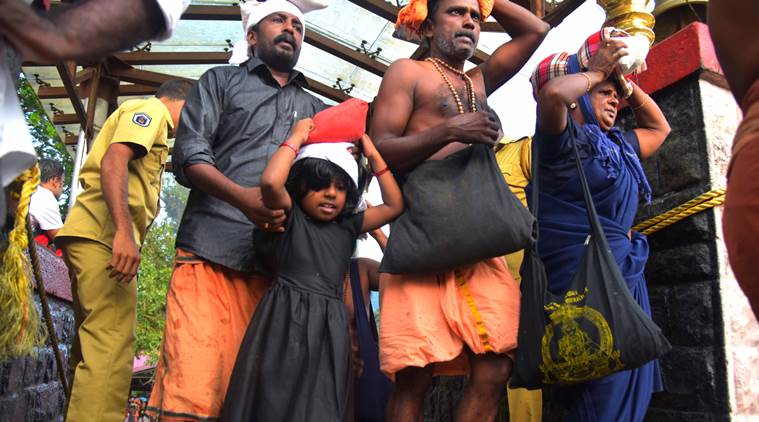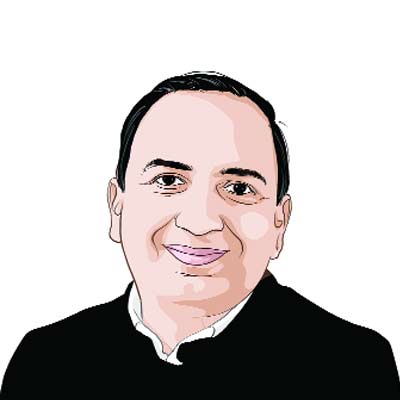The Sabarimala aftermath
Court authority is imperilled, parties have rallied behind orthodoxy, there is political fishing in troubled waters

Devotees at Kerala’s Sabarimala Temple on October 17. (Express Photo/Vignesh Krishnamoorthy)
The aftermath of the Sabarimala verdict raises an ominous political spectre. There are many legitimate concerns about the judgment. Even those who agree with the outcome worry about the broad reasoning underlying it; and conversely, many who disagree with the outcome are not reactionaries. But on the ground, in Kerala, the judgment has been used to provoke an extraordinary mobilisation to resist its implementation. Whatever our disagreements on the judgment, let us make no mistake about the dangers this mobilisation represents.
There are three issues the aftermath of the judgment raises. First, we should be under no illusion that this mobilisation is not about disagreement with this particular Supreme Court verdict. It is, rather, a full-throated mobilisation against the authority of the court itself. It is an attempt to legitimise the idea that it is perfectly fine to resist any Supreme Court judgement if one can make that resistance wear the garb of faith. There are often good reasons to disagree with our Supreme Court, and it does occasionally come up with howlers. But if this mobilisation against the judgment succeeds, it will lend credence to the proposition that any grammar of anarchy is legitimate when it comes to matters of religion. The consequence of this mobilisation is to prepare the ground for the idea that religion-based political mobilisation has a final veto over any other constitutional principle, the authority of Supreme Court be damned.
This is a very dangerous path to tread. It is striking how all the political parties and shades of opinion that were raising the spectre of anarchy when the AAP was mobilising around issues of corruption, see absolutely nothing ominous in political parties openly putting their weight behind forces prepared to use violence to prevent a Supreme Court order from being implemented. The idea that mobs can prevent and intimidate women, who are, as of now, exercising a right they have won in the Supreme Court, should worry us. The fact that mainstream political parties, rather than throwing cold water on the tensions, are actively fuelling them, is not a good sign for the rule of law. This is not a spectre that will be confined to Kerala.
The second issue is the modality of social reform. What should be the court’s role in social reform? It is hard to imagine either of the extreme views on the court’s role working. One view says this is not the court’s purview at all. This claim is obviously not correct. No court can leave it entirely to society to determine which harms on inequalities require intervention. Another view says the court should interpret its mandate for securing constitutional justice so widely that it ends up trying to interfere in almost every practice, without a sense of the scale of the harm. It tries to reconstruct all intermediate associations as if they were all meant to be mini republics, embodying all constitutional principles in their internal workings. There is something invasively wrong with this vision of the court’s mandate as well. There is an old truism that facts and norms, law and society, have to meet each other at least half-way for law to work. Law completely untethered from social norms is difficult to implement; on the other hand, complete capitulation to social norms can be capitulation to injustice. Courts, as social mediators, will always struggle to find that bright line between these positions.
One other aside about courts. It is often said that court interventions consolidate reactionaries, which is why one should be wary of them. This was not just true after Shah Bano. This is an argument also made about judicial interventions in the US, including Roe v. Wade, which helps consolidate the Right. But it is interesting that this consolidation almost always happens largely on issues of gender. While it is true that women devotees also legitimately oppose the Supreme Court judgment, the political fire being lit around it has largely to do with male privilege.
Many critics of the court want to place the onus on political parties and social movements to carry the burden of reform. I am very sympathetic to this argument. But here is a double tragedy that Sabarimala highlights. Indian political parties have been, on many issues, downright conservative, reactionary and unwilling to lead. Both the BJP and, in its own way, the Congress, are quite ready to play the politics of religious consolidation. Both are giving succour to orthodoxies that make them counter reformist rather than vehicles of reform. As for social movements, post Independence, they have often been denuded of their power. In the case of temples and trusts, there is a bizarre political alliance. On the one hand, so many Hindu institutions have been effectively taken over by the state. On the other hand, within those structures, like Devaswom Boards etc, there are no conduits for reform or debate. Even in Sabarimala, the utterances of many of its custodians reek more of misogyny than theology. But when political parties openly give succour to the most reactionary religious elements (as the Congress did after Shah Bano and as the BJP does with its orthodox army), social reform seems like a mirage. The Supreme Court’s overreach is not a cause of our dysfunction; it is a symptom. The ominous spectre of India’s two national parties lining up behind orthodoxy should alarm you.
The third axis is the larger moral psychology on display in these movements. It is true that the court judgment has given Hindu groups, always looking to play victim, another opportunity to do so. The BJP’s social energy thrives on the idea of Hindus under constant threat from an assortment of forces. For them this issue is the wedge to keep the spectre of “Hindu religion in danger” alive. Their strategy is also to provoke a state response: The spectre of the state cracking down on “devotees” defending Lord Ayyappa will be more grist for their mill. Which is why the state government is in an awkward position: The Communists may have their motives to use this for a wider culture war. But, to be fair, the Kerala CM has no option but to try and implement the Supreme Court order. He has to do it in a way that the BJP is not able to don the mantle of martyrdom.
Unleashing a religious grammar of anarchy in the face of a Supreme Court judgment, a politics of bad faith over social reform, and an outright cynical itch to provoke more political conflict, does not bode well for the republic. The true tragedy of Sabarimala will now unfold, nationally.
The writer is vice chancellor, Ashoka University. Views are personal
For all the latest Opinion News, download Indian Express App
More From Pratap Bhanu Mehta
- The battle after DussehraVijayadashmi is melancholic because the real and deep evil will surface only now, after the political triumph over Ravana has been achieved..
- It really was the economy, stupid!A deep dive into the 2008 global financial crisis, this book brings into sharp focus the international interconnections that sank the world economy ..
- Liberty without statismSupreme Court upheld individual freedom, dignity, equality in Sabarimala case. But statism has its own dangers. ..







































No hay comentarios:
Publicar un comentario